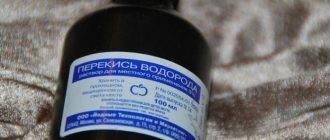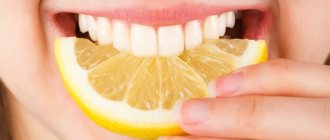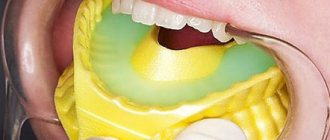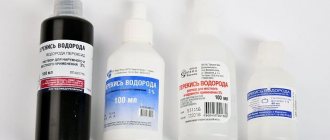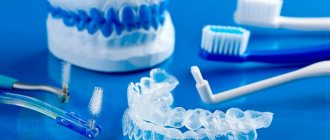How does peroxide work?
The whitening effect of hydrogen peroxide is based on a chemical oxidation reaction in which active oxygen breaks down organic compounds into simple substances: water and carbon dioxide.
When hydrogen peroxide interacts with tooth enamel, it penetrates deeply into tooth tissue, brightens them, but at the same time partially destroys the organic matrix of the tooth.
To reduce the destructive effect of hydrogen peroxide on tooth enamel during whitening, it is recommended to use gels with carbamide peroxide, which is less active, but also safer. Thanks to the glycerin or carbolic base of such gels, oxidation occurs more slowly and the enamel is less damaged.
The result of teeth whitening with hydrogen peroxide: photo after
Hydrogen peroxide - what is it?
When talking about bleaching with hydrogen peroxide, we mean using its pharmaceutical solution with a concentration of 3 percent . Hydrogen peroxide is a colorless, odorless liquid. Its purpose is the primary treatment of wounds, abrasions and other damage to the skin.
Due to its chemical composition, this product is included in the group of oxidizing agents, having a pronounced whitening property. That is why this solution can be used to lighten tooth enamel at home.
Whitening with hydrogen peroxide occurs due to chemical oxidation reactions . As a result, we get the decomposition of organic compounds from exposure to active oxygen. Tooth enamel, when exposed to peroxide, is lightened due to the penetration of the solution into deep tissues. However, this method cannot be considered absolutely harmless, since it partially destroys the tooth enamel.
How quickly is the effect achieved?
If you are planning to whiten your teeth at home using hydrogen peroxide, you should not expect quick results and significant lightening of the enamel. The speed at which the first noticeable effect appears depends on the individual characteristics of tooth enamel and the reasons for the change in its color.
In order to notice minimal improvements, regular whitening treatments must be carried out over several weeks.
If yellowing of teeth is caused by drinking coffee or black tea, then the effectiveness of home methods can be quite high and the whitening process will be fast. With smoking, the situation is much worse, since tobacco dyes penetrate much deeper into the enamel and are practically not affected by weak concentrations of hydrogen peroxide. In addition, if the natural color of teeth is quite dark, then it is almost impossible to significantly lighten it at home.
Reading people's opinions
There is such a category of people as “advanced amateurs”. They do not have diplomas or scientific degrees, but even the famous “Myth Busters” can envy their experience. I trust their opinion at least a little. Their opinion is not based on rumors, but on “checked and described.” So, I read their reviews about teeth whitening with baking soda and hydrogen peroxide first.
Conclusions:
- you can whiten and not be left without teeth;
- some people begin to have problems with enamel demineralization;
- There are no products that will whiten your teeth for pennies by several shades at home.
Focal demineralization of tooth enamel
Yes, by the way, let me remind you that many dental methods that are offered in the best clinics in our country are based precisely on the activation of peroxide in special pastes and gels using ultraviolet lamps. Of course, there is a huge difference in price between this method and cotton pads with peroxide. But under the supervision of a dentist and using special equipment, it turns out to be more reliable and safer.
5 professional ways to whiten teeth:
| Name | Photo | Description |
| Air-Flow | Hardware technology that removes external plaque and brightens tooth enamel by 1-3 tones | |
| Ultrasonic cleaning | Used to remove deposits, plaque and tartar in the oral cavity | |
| Chemical professional teeth whitening | This technique is the least safe whitening in dentistry, as it increases the development of tooth sensitivity | |
| Photobleaching using the ZOOM system | This procedure does not cause discomfort. Upon completion, the teeth are treated with an amorphous calcium compound, which strengthens tooth enamel. | |
| Laser whitening | Very expensive and effective teeth whitening in dentistry. Has a positive effect on enamel and strengthens it by forty% under the influence of a laser beam |
Next, I decided to ask my friends if anyone had used teeth whitening with soda and hydrogen peroxide. Some said they tried it. After brushing with soda, my teeth began to react to hot and cold. Methods with peroxide required long-term use and many simply did not have the patience.
Beautiful teeth
The dentist, whom I’ve been going to for dental treatment for five years now, said straight out: “It’s possible, if you’re careful.” But not everyone and not often. Otherwise, you will then run to the doctors to restore the enamel.
I came to the conclusion for myself that it is better not to show off and not risk the health of my teeth. Paying for professional cleaning and whitening is much safer than being afraid that you will damage your tooth enamel using homemade methods from the Internet. They won't recommend that either. As one doctor I know said, extreme sports enthusiasts can even brush their teeth with Domestos, and then write “effectively, but the main thing is not to swallow it.” Some will get away with mild poisoning or burns to the mucous membranes, while others will not have time to pump out.
Whitening your teeth yourself
In general, do not experiment on yourself. It’s better to turn to professionals who will help you restore the whiteness of your teeth and the confidence that your smile is dazzling. Good luck!
Indications and contraindications
Despite its popularity, teeth whitening may not be suitable for everyone. There are situations where this technique can be quite effective. But it also has a number of contraindications.
Indications:
- Changes in the shade of tooth enamel caused by drinking coffee, red wine or smoking.
- Natural yellowish or gray enamel color.
- Changes in tooth color as a result of natural aging processes.
- Yellowing of enamel after taking tetracycline antibiotics or excessive consumption of fluoride preparations.
Contraindications:
- the entire period of pregnancy and lactation;
- a history of allergic reactions to hydrogen peroxide;
- active damage to teeth by caries or if there are a large number of fillings;
- acute and chronic diseases of the mucous membranes of the oral cavity and gums;
- periodontal diseases (periodontitis, periodontal disease);
- wearing braces;
- the presence of open pulp (bleaching can cause severe burns of dental tissue);
- thinning of tooth enamel due to increased abrasion or congenital dental pathologies;
- increased sensitivity of teeth to high and low temperatures;
- malignant neoplasms of any location.
Contraindications
Keep in mind! Like other methods, bleaching with this solution has a number of contraindications:
- Advanced caries .
- Bleeding gums.
- Increased sensitivity of enamel.
- Use of braces or plates .
- Diseases of the intestines or stomach.
- Pregnancy and lactation period.
- Age up to 12 years .
- Mouth ulcers.
- Availability of prostheses.
- Pulpitis.
Folk recipes
There are several methods for whitening teeth using hydrogen peroxide. An important point is to strictly follow all recommendations and use only a 3% solution of the drug for such purposes. A higher concentration will not speed up the whitening process, but will significantly damage tooth enamel.
- The simplest recipe for teeth whitening is to rinse your mouth daily with a hydrogen peroxide solution. Before the procedure, you must thoroughly brush your teeth with fluoride toothpaste. This will help protect the enamel and prevent its destruction. Then, for 1 minute, rinse your mouth with a 1.5% solution of hydrogen peroxide (3% solution diluted with water in a 1:1 ratio). Then rinse your teeth with water and refrain from eating and drinking for at least 30 minutes.
- Whitening with soda and peroxide gives good results . Mix regular baking soda with 3% hydrogen peroxide until a thick mass is obtained. This paste is carefully applied to the surface of the teeth using a cotton swab or fingers. It is necessary to ensure that it does not get on the gums and mucous membranes. After 2-3 minutes, rinse your mouth with water and brush your teeth with prophylactic toothpaste with fluoride. A big mistake is to use this technique with a toothbrush. This severely damages and thins tooth enamel.
- You can make a whitening toothpaste out of regular toothpaste by adding a few drops of hydrogen peroxide and lemon juice to it before brushing. This type of bleaching is quite safe for the enamel and does not cause significant damage to it.
Teeth whitening with peroxide, baking soda and lemon
Reviews
Valentina Kravchuk, 24 years old. For prevention, I rinse with diluted hydrogen peroxide once a week. The result is pleasing. I think this is a good budget option, but it is only effective if the safety rules are strictly followed.
Ksenia Alyokhina, 30 years old. My husband practices teeth whitening with soda and peroxide. He wipes his teeth 2 times a week and brushes 2 times a day with simple toothpaste. The teeth are white and beautiful. I was afraid, but this is the second week I’ve been doing the same procedure: the yellowness on my teeth is slowly disappearing. In principle, I am satisfied with the effect, but the big minus is that I had to reduce my coffee consumption.
Evgeny Malykhin, 27 years old. I smoke and drink black tea 4-5 times a day, so I would like to have a better teeth color. I wanted to lighten my teeth, but after visiting the dentist and learning about the price, I gave up on this idea. On the Internet I came across a site with a lot of recipes. After reading the reviews, I decided to use a recipe that uses baking soda and lemon juice. I make the following mixture: I dissolve baking soda with lemon juice and brush my teeth with a soft-bristled brush 2 times a week. The teeth have already become noticeably lighter, and not a trace remains of the plaque. I’m thinking of quitting smoking and replacing black tea with green tea, in theory the result will be better.
Possible consequences and complications
Like any other teeth-lightening agent, hydrogen peroxide can cause a number of complications:
- “Re-whitening” - the surface of the teeth loses its natural glossy shine, becomes matte and looks like white chalk.
- Demineralization is an increased leaching of minerals from tooth enamel with the formation of white spots - harbingers of caries.
- Increased sensitivity of teeth to cold and hot foods, as well as to acid.
Such conditions require professional dental care and procedures to strengthen the enamel and remineralize it.
Pros and cons of soda
Strictly speaking, there are three advantages:
- price - soda costs a penny;
- speed of impact;
- simplicity and the ability to do everything right in your bathroom.
Pros and cons of using soda
Unfortunately, there are more disadvantages:
- the effect of soda does not last long, and the procedure can be repeated no more than once every 7-10 days;
- care is extremely superficial;
- after treatment, bleeding from the gums may begin;
- allergic reactions are possible;
- irritation of the oral mucosa is possible;
- the sensitivity of tooth enamel increases.
3 Ways to Whiten Teeth with Hydrogen Peroxide
You can draw your own conclusions. About adding lemon in a dental article that I found, it is written that the acid, when combined with soda, will cause even more damage to the enamel, for which the procedure itself is already a “shock.” Of course, there are many adherents of the method who show photos before and after teeth whitening with soda. Moreover, often in the photo there are veneers, and not real teeth whitened with folk remedies.
Increased tooth sensitivity is a very unpleasant phenomenon.
Science verdict:
- yes, it works.
- no, it's not safe.
Professional whitening with the Air Flow sandblasting system uses baking soda to clean and polish enamel. This method is considered more progressive and gentle.
Air Flow
Video - Whiten teeth in 5 minutes with soda
How often can I use it?
Is it possible to use hydrogen peroxide on a regular basis to maintain a white smile? The answer to this question is clear - no.
The systematic use of oxidizing agents is very harmful not only to dental tissues, but also to the mucous membranes of the oral cavity.
In order to give your smile a beautiful whiteness, you can use hydrogen peroxide only for a few weeks a year. The rest of the time, it is necessary to maintain the achieved effect using conventional hygiene products and gentle whitening toothpastes.
Important Tips
Is peroxide so dangerous for teeth whitening in the form of a 3% liquid? Indeed, in dentistry it is used in much higher concentrations. This substance is the main component of many cleansing gels for mouth guards. This means that a household solution can be used to lighten teeth at home. But it is important to follow the recommendations:
- At home, do not increase the concentration of the solution. To whiten teeth using peroxide, a 3% solution is sufficient.
- Observe the reaction of the gums, mucous membranes and lips. If you experience any unpleasant or painful sensations, stop the procedures.
- Use only fresh solution and store it properly, sealed and in a cool place.
- Don't expect miracles. The whitening effect will become noticeable no earlier than after 2 weeks - this is a standard whitening course.
It takes time to whiten enamel - Do not swallow the solution under any circumstances. If this happens, urgent gastric lavage is necessary.
- Don't eat or drink anything other than water for 30 minutes after bleaching with hydrogen peroxide.
Important to pay attention
In order to whiten your teeth with hydrogen peroxide as safely as possible, you must follow the following recommendations:
- Do not use a solution with a concentration higher than 3%. This is fraught with serious burns of the mucous membranes and irreversible destruction of the enamel.
- If you experience the slightest discomfort, discomfort or burning sensation, you must immediately stop the procedure and rinse your mouth thoroughly with clean water.
- You should refrain from bleaching enamel with peroxide if there are unhealed wounds, cracks or ulcers in your mouth.
- For bleaching, you should use a fresh solution of hydrogen peroxide, since it quickly loses its active properties when exposed to air.
- A prerequisite before the first whitening procedure is to check for possible allergic reactions.
What do they say about this method?
It is necessary to use hydrogen peroxide for teeth whitening only when you are absolutely sure that it will not cause an allergy. To check this, you can apply it to the back of your hand for a short time. If no reaction occurs, then the product can be used.
If during the procedure you feel a slight tingling and slight burning sensation, then you should know that this is normal. The most important thing is not to overdo it. Pure 3% peroxide should not be held in the mouth for more than a few seconds.
When using hydrogen peroxide only for preventive purposes, in order to maintain the effect of professional whitening, the procedure can be performed once a week. It would be enough. If you intend to whiten your teeth at home, remove stubborn plaque, and remove yellowness, then the procedure will need to be performed more often.
Before using peroxide, you should consult your dentist. Not because of any great danger of this substance, but due to the fact that peroxide should not be used if there is increased sensitivity of the teeth and advanced caries.
Excessive use of peroxide can lead to thinning of the enamel, changes in the structure of the teeth, or their destruction. There is also a chance of getting your gums burned.
To ensure that teeth whitening with hydrogen peroxide does not have strong negative consequences, you should follow some precautions, namely:
- only a 3% solution is allowed to be used;
- swallowing peroxide after rinsing is prohibited;
- After each whitening procedure, your mouth should be rinsed with warm water;
- You can eat no earlier than an hour after bleaching.
Many people use this method to achieve whiter teeth at home. Most of them who adhere to the recommendations get the desired effect.
Yellowness or plaque on tooth enamel appears due to frequent consumption of junk food, coffee, tea, and smoking. But not everyone can refuse a morning aromatic drink or delicious food. Removing plaque with peroxide is a chemical oxidation process. When the solution comes into contact with the enamel, it penetrates even into the deepest tissues of the tooth, helping to lighten it, but this process does not pass without consequences. As a result of oxidation, rapid depletion and microdamage of the enamel layers occurs.
Although hydrogen peroxide has good whitening properties, it has serious side effects. Possible complications include:
- Demineralization. It occurs due to the depletion of enamel, because during bleaching, hydrogen peroxide washes out minerals. White spots appear on the teeth, then caries forms in their places.
- Re-bleaching. Sometimes it happens in people who very often resort to the procedure. As a result of excessive whitening, the top layer of enamel is completely erased, teeth lose their natural glossy shine, and become chalk-like in color. When re-whitening, you must immediately contact your dentist.
- Hypersensitivity to acid, cold or hot foods. Very often it occurs as a result of depletion of the enamel and the appearance of cracks on it. Discomfort is eliminated with the help of a special toothpaste.
- Gum irritation. Appears due to exposure of the gums to a high concentration of solution. If such a symptom appears, you should stop the whitening procedure and contact your dentist.
You should not whiten your teeth with hydrogen peroxide if:
- Pregnancy, lactation.
- Damage to teeth by caries.
- Open pulp.
- Diseases of the oral cavity and gums.
- Fine enamel.
- For periodontal disease or periodontitis.
- Increased sensitivity of teeth to cold or hot food.
- The presence of malignant neoplasms or wounds in the mouth.
- Wearing braces.
- Allergies to the solution.
DETAILS: What are the home remedies for teeth whitening?
Enamel whitening with peroxide is usually achieved for the following indications:
- When teeth change and darken during natural age-related changes;
- If the darkening of the enamel occurs due to drinking coffee and other drinks that contain coloring substances, as well as smoking;
- Yellowing of the enamel with increased use of toothpastes with a high fluoride content, which are intended for the prevention of carious lesions;
- For yellowing of enamel due to increased use of tetracycline.
Smoking is a bad habit that leads to the appearance of bile plaque on the teeth, which can darken, as well as provoke the formation of tartar and inflammation of the gums.
Before using hydrogen peroxide for teeth whitening, you should pay attention to the fact that this product has a large number of contraindications. The most common contraindications include the following:
- Having an allergy to hydrogen peroxide;
- Application of bracket systems;
- If there are malignant formations in the oral cavity;
- Bleaching is not recommended if there is open pulp. Otherwise, soft tissue burns may occur;
- Caries or if there are many teeth with fillings;
- Dental diseases in which periodontal damage is observed - periodontitis and periodontal disease;
- Congenital diseases in which there is an increased degree of enamel thinness;
- Do not use if you are hypersensitive to temperature changes;
- Diseases of the oral cavity in chronic and acute form;
- During pregnancy or breastfeeding.
It is not recommended to whiten with hydrogen peroxide: during pregnancy, wearing braces, poor condition of teeth or oral mucosa, allergic reactions to hydrogen peroxide, etc.
- Teeth have changed color and darkened as a result of natural aging of the body;
- The enamel has darkened as a result of drinking coffee and other drinks containing dyes, as well as smoking;
- The enamel has turned yellow due to excessive use of fluoride toothpastes intended for the prevention of caries;
- Yellowing as a result of taking tetracycline;
- Naturally yellowish or gray tint.
Despite its effectiveness and prevalence, the method has a number of contraindications, and categorical ones:
- Allergy;
- Braces are used;
- There are malignant neoplasms in the oral cavity;
- Bleaching is contraindicated in the presence of open pulp. Otherwise, the internal tissues of the tooth may get burned;
- Caries, or too many fillings;
- Periodontitis and periodontal disease;
- As a result of congenital pathology, teeth have very thin enamel;
- Teeth have increased sensitivity to high or low temperatures;
- Chronic or acute diseases of the oral cavity (mucous membrane);
- The period of pregnancy and breastfeeding.
You should start brushing your teeth with hydrogen peroxide in the following situations:
- grayish enamel color;
- change in the shade of teeth towards darkening due to smoking, drinking strong tea or coffee;
- the appearance of yellowness on the enamel after taking antibiotics;
- age-related disappearance of whiteness.
If you decide to whiten your teeth with hydrogen peroxide at home, it is advisable to first obtain a qualified consultation from a dentist.
It is imperative to take into account that there are certain contraindications to the use of hydrogen peroxide:
- pregnancy;
- breastfeeding period;
- development of periodontal disease;
- gum disease;
- increased sensitivity of enamel;
- extensive carious process;
- the presence of a large number of fillings;
- installed braces;
- allergy to peroxide;
- childhood and adolescence.
If any of the above factors are present, it is necessary to select other teeth whitening methods.
There are several methods that allow you to lighten teeth that have darkened for various reasons using hydrogen peroxide.
- Rinsing
Prepare a rinse solution. For this, three percent peroxide is poured into water 1:1. Now brush your teeth using fluoride toothpaste. After this, rinse your mouth with the prepared solution for one minute without swallowing it. The appearance of bubbles is due to the occurrence of a chemical reaction and indicates the effectiveness of the process of destroying the contaminant layer. At the final stage, rinse with water.
You can make your breath fresh and your teeth white by rinsing with peroxide diluted in water 1:2 with the addition of a teaspoon of baking soda and salt on the tip. After completing this manipulation, you should definitely clean your teeth using a brush with constantly used toothpaste.
Food should be taken no earlier than 30 minutes after the rinsing procedure.
- Using peroxide in combination with baking soda
The most effective way to whiten tooth enamel with peroxide is to add baking soda to it in an amount that ensures the consistency of thick porridge when mixed. You can add a little fine salt if desired.
With the resulting fairly active mass, it is advisable to brush your teeth without a brush, which will allow you to act more gently on their surfaces. It is more convenient to apply the mixture with your fingers, rubbing with massaging movements for two minutes. You can take a cotton swab. It is necessary to avoid getting peroxide and soda on the gums, which may become irritated. To completely eliminate peroxide residues, carry out additional cleaning with a paste.
- Homemade whitening paste
When deciding how to whiten teeth with hydrogen peroxide, you can choose the option of creating a homemade paste that has whitening characteristics. Take your usual paste, although to reduce the negative effects of peroxide they recommend varieties with fluoride, squeeze it onto the brush and add 4-5 drops of peroxide on top. You can add a little lemon juice to enhance the brightening effect.
When answering the question whether it is possible to get a snow-white smile after using hydrogen peroxide as a teeth whitener, it should be noted that it brightens by no more than two shades.
- Fast whitening
If there is a need to urgently tidy up your teeth, ensuring their whiteness and freshness, use a mixture of lemon juice and soda (a teaspoon each), into which hydrogen peroxide (4 - 5 drops) is poured. Distribute the composition onto the enamel and leave without closing your mouth for two minutes. After rinsing, brush your teeth with your usual toothpaste.
The main indicators for use are:
- yellowing of tooth enamel after excessive consumption of coloring foods and antibiotics;
- change in enamel shade or darkening due to natural aging;
- discoloration that results from frequent use of fluoride products;
- grayish and yellowish tone of enamel from nature;
- the appearance of stains due to prolonged smoking.
Possible complications
Harm and benefits to teeth from hydrogen peroxide: what is their extent? If we consider the beneficial properties of this substance, we cannot fail to note the harm it can cause. So, among all the possible complications and side effects, the following can be noted:
- new sensitivity to hot food, water and acid;
- gum irritation;
- demineralization;
- excessive whitening, as a result of which the teeth lose their natural shine;
- changes in taste sensations;
- burning;
- development of hyperesthesia.
Precautionary measures
So that such lightening does not turn into a tragedy, and the procedure itself brings the expected result, it is important to adhere to the following recommendations when carrying out it:
- Before starting whitening, you need to test to see if you are allergic to peroxide. To do this, you need to apply a few drops of it to your wrist and monitor the condition of your skin throughout the day. If it turns red or itches, it should not be used.
- Use only a product with a concentration of no more than 3%. If the concentration is higher, a person risks getting a burn to the mucous membrane and damaging the enamel.
- The appearance of an unpleasant sensation, burning, or tingling during lightening is a signal that it has stopped.
- For the procedure, use only fresh solution. Long-term storage of an opened bottle will lead to a decrease in oxygen activity and the liquid will lose its brightening effect.
- It is not recommended to perform lightening if there are unhealed wounds, ulcers, or cracks in the mouth.
- Upon completion of the procedure, do not drink drinks (except pure water without gases) or eat for 2-3 hours.
- In the first 2-3 days, exclude from the diet foods that contain dyes and, if possible, do not smoke.
- The course should not last more than 2 weeks.
Lightening with peroxide is not recommended more than 2 times a year.
Before undergoing it, you should visit your dentist. He will determine the absence or presence of restrictions for performing whitening, and will give the necessary advice and explanations.
Possible complications and disadvantages
Peroxide gives good whitening results. But its frequent or incorrect use leads to negative consequences. The most severe and undesirable of them are:
- Dental hypersensitivity – the appearance of discomfort, sharp pain when drinking cold (hot) drinks and eating food.
The reason for the development of this condition lies in the thinning of the enamel. But this process is reversible. When such a symptom appears, you need to start using special gels or pastes that saturate it with essential minerals and block the sensitivity of nerve endings. - Chalked teeth (over-whitened) - this complication is diagnosed in rare cases and only in patients who have used peroxide in combination with baking soda for a long time as a dental whitener.
The surface layer gradually wears off and reveals subsequent (internal) layers. The shine is gradually lost, and the tooth resembles a chalk-covered surface. It is not possible to restore your teeth to their original healthy appearance on your own. - Demineralization is the formation of small whitish spots on the enamel, which become more pronounced over time.
Their appearance indicates the loss of substances and minerals important for teeth. If measures are not taken to eliminate this symptom in a timely manner, demineralization will eventually lead to tooth fragility and subsequent destruction.
Short-term complications may also occur: irritation of the mucous membrane, changes in taste perception, burning sensation. These signs usually disappear after stopping peroxide bleaching and rinsing the mouth repeatedly.
Important: given the complications that may occur after such a procedure, peroxide should be used with great caution and under the supervision of a dentist.
Safety precautions
In order for teeth whitening with hydrogen peroxide at home to take place with the least negative consequences and the most effective results, you must adhere to the tips clearly laid out below. Only in this case will reviews about teeth whitening thanks to peroxide be only positive.
Main contraindications
The main contraindications are:
- period of bearing a child or breastfeeding;
- allergic reactions of the body to any bleaching substances;
- the use of individual products, especially photosensitive ones;
- age (children and adolescents);
- the presence of crowns, fillings, recent or old restorations in the area that will be subject to bleaching, any carious cavities;
- It is also not recommended to use hydrogen peroxide after tooth extraction;
- general diseases (asthma, hypertension, oncology, endocrine diseases, etc.);
- diseases of the intraoral cavity;
- enamel hyperesthesia, during which it is also prohibited to wipe teeth with hydrogen peroxide;
- visually visible loss of enamel, which is the result of pathological or age-related changes;
- the presence of a strong gag reflex;
- periodontal diseases.
In any of the above cases, neither toothpaste with peroxide nor rinses are suitable. All these experiments can be carried out only after consultation with a dentist.
Is hydrogen peroxide dangerous for teeth or not? We can confidently say that while complying with all safety technologies, its destructive impact is minimized.
Precautionary measures
The precautions are as follows:
- In order not to damage the enamel and not burn the oral cavity, you need to use only a 3% peroxide solution.
- Before using peroxide, you need to conduct an allergy test for it.
- It is necessary to use only fresh composition, since due to contact with air molecules, an open bottle loses its properties.
- If any unpleasant sensations occur, it is best to complete the procedure and also rinse your mouth with purified water.
- Before performing any of these procedures, it is advisable to visit a dentist, who will give recommendations on how to perform them correctly and answer basic questions, including how to remove tartar with hydrogen peroxide. If there are contraindications, the dentist can tell you how to whiten teeth without hydrogen peroxide.
- During the presence of ulcers, cracks and other damage in the oral cavity, it is advisable to postpone the procedure.
- Visit the dentist once every six months.
- Repeat the process no more than once every 1-2 years.
- For the first two days, do not consume any coloring products, do not smoke, or drink coffee.
Possible consequences
Now you know how to whiten darkened teeth with hydrogen peroxide. A two-week course of any of the presented options can be repeated 4 times a year if your enamel can withstand such cleaning. Without knowing the measures in pursuit of ideal whiteness, you may notice that the whitening effect is accompanied by the destruction of the deep layers of the tooth - dentin. What are the risks of abusing hydrogen peroxide or ignoring contraindications:
- Unnatural whiteness with loss of gloss.
- Damage to the gums with bleeding, ulcers on the mucous membrane, irritation of the lips.
- Demineralization. Here you can notice small white spots on the enamel - this is how the teeth are deprived of mineral components. This can be considered a harbinger of caries and destruction of tooth tissue.
When using any of the whitening methods, you need to know when to stop.
Experiments with peroxide led to disastrous results? Any consequences can be corrected if you do not postpone your visit to the doctor. The dentist will assess the condition of the enamel, strengthen it with special means and perform a remineralization procedure. Be prudent - approach the methods of how to properly whiten your teeth at home, with full responsibility for your health.

